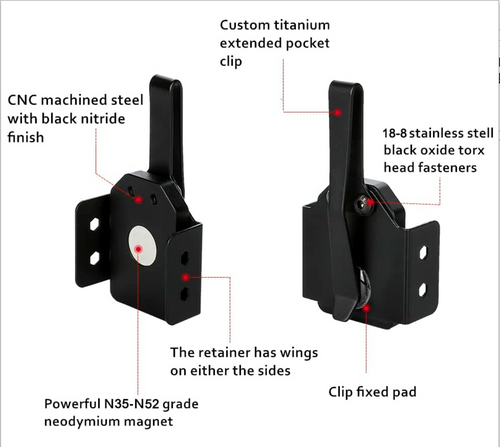Your inside-the-waistband (IWB) holster is a key part of safe and effective firearm carry. Over time, wear and tear can make your holster unsafe or uncomfortable. Here's a quick guide to identifying when it’s time to replace your holster:
- Weak Retention: If your firearm doesn’t stay securely in place during daily activities or draws.
- Physical Damage: Cracks, tears, softening, or warping that compromise safety and performance.
- Failing Hardware: Loose screws, worn clips, or other hardware issues that affect stability.
- Discomfort: Persistent irritation, pressure points, or difficulty moving freely.
- Warping: Misshapen holster body or collapsed openings that hinder re-holstering.
- Moisture Issues: Mildew, bad odors, or stiffness caused by sweat or dampness.
- Changed Needs: If your holster no longer suits your lifestyle or daily activities.
- New Firearm: A holster that doesn’t fit your new firearm properly.
Key takeaway: Regularly inspect your holster for these signs. If you notice any issues, it’s time to replace it to maintain safety, comfort, and performance.
Upgrade Your IWB Carry: The Cloak Tuck 3.5 Inside the ...

1. Weak or Failed Retention
The retention of your inside-the-waistband (IWB) holster is critical for keeping your firearm secure. If the retention starts to weaken, it’s a clear sign that your holster may no longer provide the necessary safety and should be replaced.
How to Check Retention
To test your holster’s retention, use an unloaded firearm and a barrel block. Perform the following movements while wearing the holster with your regular attire:
- Jump, do burpees, and sprint
- Go through your usual daily activities and positions
- Practice a smooth, clean draw without resistance
- Confirm that the firearm stays secure during all these actions
Retention ensures your firearm remains securely in place until you intentionally draw it, allowing for safe and easy access. A loss of retention not only affects your ability to draw effectively but also increases safety risks.
Safety Concerns
An example of poor retention highlights the risks: an FBI agent lost his firearm during a dance-floor backflip, which led to an accidental discharge that injured someone nearby. This incident underscores how essential a secure holster is for safe firearm carry.
A good holster balances security and accessibility. Several factors influence retention, including:
- Design elements like molding and adjustable tension
- Pressure from your body against the holster
- Belt tension that keeps the holster in place
In one case, a concealed carrier involved in a rollover car accident benefited from proper retention when their firearm stayed securely in the holster, avoiding additional dangers during the crash.
If you notice that your firearm no longer fits snugly or retention has weakened, replace your holster to maintain safety and reliability.
2. Physical Damage
Physical damage can compromise both the safety and functionality of your holster. Understanding the common types of damage is key to keeping your carry setup secure.
Types of Material Damage
- Cracks and Tears: These often develop at stress points, like where the holster attaches to clips or near the trigger guard.
- Worn Edges: Frequently found around the holster's opening due to repeated drawing and re-holstering.
- Softening: Seen mostly in leather holsters, where the material loses its rigidity over time.
- Surface Deformation: Includes creases, indentations, or warping that alter the holster’s original shape.
Regularly inspect these areas to catch early signs of wear.
How Damage Affects Use
Physical damage can severely impact your holster’s performance. A case reported by ITS Tactical highlights the risks: a worn leather holster developed a soft spot and crease, which pressed against the trigger of a Glock 19. This caused an accidental discharge, with the bullet passing through the user’s pants, car seat, and door frame.
Compromised Trigger Protection
- Soft spots can press against the trigger.
- Deformed surfaces reduce proper trigger coverage.
- Trigger safety is jeopardized by insufficient material rigidity.
Reduced Retention Capability
- Damage weakens the tension needed to secure the firearm.
- Warping can loosen the holster’s grip on the gun.
- Worn surfaces may lead to inconsistent retention.
Draw Stroke Problems
- Snags during the draw or re-holstering process.
- Deformed openings make access difficult.
- Damage disrupts the angle and consistency of your draw.
"If your leather is getting soft and worn, be sure that it won't interfere with your trigger or just replace it." - The ITS Crew
Don’t take risks with a damaged holster - replace it immediately to maintain safety. Up next, we’ll look at how hardware issues can further weaken holster reliability.
3. Failing Hardware
Hardware problems can undermine the safety and reliability of your holster. Knowing the signs of these issues can help you determine when it's time to replace your holster instead of attempting repairs.
Common Hardware Problems
Hardware issues often develop over time. Here are some common problems to watch for:
- Clip wear and tear: Loss of spring tension, visible stress marks, or mounting problems like loose screws, stripped threads, missing washers, or worn mounting points.
- Screw issues: Front clip screws can loosen over time, which may lead to cracks along the edge of the kydex material.
Risks of Hardware Issues
These problems can lead to serious safety risks, such as the holster detaching during a draw, reduced retention, unstable carrying, or inconsistent draw angles.
"When the issue of spring-steel metal clips arises, many folks will complain that their clips have lost their 'spring' and are loose." - Professor Paul Markel
To reduce the risk of hardware failure, follow these steps:
- Use blue threadlocker on clean, secure screws to prevent loosening.
- Test clip tension weekly by checking its grip on your belt.
- Inspect all mounting points regularly as part of your maintenance routine.
Signs of Imminent Hardware Failure
Keep an eye out for these warning signs to avoid sudden failures:
| Sign | What to Check | When to Replace |
|---|---|---|
| Clicking Sounds | Loose screws or mounting points | Replace immediately if tightening doesn’t fix it |
| Clip Movement | Loss of spring tension or secure grip | Replace when clips feel loose after adjustment |
| Visible Wear | Stress marks on clips or mounting areas | Replace before complete failure occurs |
"You need clips that will keep your holster attached to your body when you draw." - Concealed Carry Inc.
Regularly checking your holster's hardware is just as important as monitoring its retention and fit. Make it part of your routine to assess the overall wear and comfort of your holster.
4. Increased Discomfort
When your holster starts causing discomfort, it’s a clear sign something’s not right. It’s important to distinguish between minor adjustments and discomfort that signals a bigger issue.
Pain Points to Watch For
A good holster should let you move freely without pain or restriction. Here are some common discomfort issues and what they might mean:
| Type of Discomfort | What to Check | When It’s a Problem |
|---|---|---|
| Pressure Points | Muzzle pressing into the pelvis; gun conflicting with body shape | If discomfort remains even after repositioning |
| Friction Issues | Gun moving excessively against the skin | If rubbing doesn’t stop after adjusting |
| Skin Irritation | Heat and moisture buildup | If cleaning doesn’t solve the irritation |
| Balance Problems | Uneven weight distribution | If the gun won’t stay stable in its position |
These discomforts often point to deeper problems that can affect your ability to carry effectively.
"Contrary to popular belief, carrying a gun is NOT supposed to be painful, and you ARE supposed to have a full range of motion. Pain is not normal, and it's not something you have to just 'get used to.'" - PHLster Holsters
Effects on Daily Carry
Discomfort doesn’t just affect how you feel - it can interfere with your daily carry in important ways:
- Physical effects: You might notice changes in your posture, limited movement, skin irritation, or even muscle strain.
- Behavioral changes: Frequent holster adjustments, inconsistent positioning, and reduced awareness of your surroundings can all result from discomfort.
"Pain signals potential tissue damage." - PHLster Holsters
Check your setup carefully. Your firearm should sit flat, and your belt should feel secure. If the discomfort doesn’t go away, it may be a warning sign that your holster needs to be replaced.
sbb-itb-7fb5bb8
5. Warped or Misshapen Body
A warped holster can jeopardize firearm security and ease of use. Like retention or hardware problems, warping poses safety risks and affects how well your holster performs.
Signs of Warping
Warped holsters often show these noticeable issues:
| Deformation Type | Visual Indicators | Potential Safety Impact |
|---|---|---|
| Body Softening | Sagging when the holster is empty | Reduced retention; the firearm might shift or fall out |
| Mouth Deformation | Uneven or collapsed opening | Makes safe and efficient re-holstering difficult |
| Surface Rippling | Waves altering the holster's shape | Causes inconsistent draw friction and snag points |
These changes not only indicate wear but also directly affect how the holster functions.
Impact on Performance
A warped holster can disrupt key functions, such as:
- Draw Consistency: Warping makes it harder to maintain a secure grip during the draw.
- Retention Issues: A warped holster may lose tension, allowing the firearm to move around or creating unsafe pressure points.
- Re-holstering Safety: A collapsed holster mouth can make re-holstering unsafe and affect your overall awareness.
If you notice any of these issues, it’s time to replace your holster. To prevent warping, store it in a cool, dry place and avoid using products like saddle soap or mink oil that can over-soften the material.
6. Bad Smells and Moisture Damage
Carrying inside the waistband (IWB) exposes holsters to sweat and moisture, which can cause damage over time. Knowing how to spot and handle these issues helps protect both your holster and your firearm.
Spotting Moisture Problems
Moisture damage usually develops slowly, but there are clear signs to watch for. Here's a quick guide:
| Warning Sign | What to Check | When to Replace |
|---|---|---|
| Musty Odors | Interior lining and seams | If cleaning doesn’t eliminate the smell |
| Mildew Spots | Dark patches or discoloration | As soon as you notice them |
| Material Stiffness | Loss of leather flexibility | When the material feels brittle or rigid |
| Surface Residue | White powder residue | If it reappears after cleaning |
If you notice any of these signs, take immediate action:
- Let the holster air dry using a fan.
- Treat mildew with a mixture of rubbing alcohol and water (equal parts).
- To remove odors, place a nylon stocking filled with baking soda inside the holster overnight.
Protecting Your Firearm
A damp holster isn’t just bad for the holster - it can also lead to firearm corrosion. To avoid this:
- Avoid storing a wet holster in plastic, as it traps moisture.
- If cleaning and maintenance don’t resolve moisture problems, it’s time to replace the holster to ensure your firearm stays safe and performs as expected.
7. No Longer Fits Your Needs
Sometimes, your holster stops working for you - not because it’s worn out, but because your lifestyle has changed. It’s important to recognize when your holster no longer meets your needs to ensure safe and effective concealed carry.
Changes in Carry Habits
As your daily routine becomes more active, your current holster might not keep up. For example, if you’re moving more or engaging in physical activities, your holster may lack the retention needed to stay secure during these movements.
Improved Holster Designs
Newer holsters often come with features like better retention systems, moisture-wicking materials, adjustable settings, and designs that feel more natural to wear. If your current holster is uncomfortable or limits your efficiency, it might be time to upgrade to something that works better for you.
You should think about replacing your holster if:
- It causes ongoing discomfort during wear
- You constantly need to adjust or reposition it
- It restricts your natural movement
- Your daily activities outgrow its functionality
8. New Firearm Purchase
When you get a new firearm, your current IWB holster might not fit it properly. A new firearm requires a holster designed specifically for its size, shape, and controls.
Why Fit Matters
A well-fitted holster is essential for carrying your firearm safely. It should be molded to match your handgun's exact make and model to provide:
- Full trigger guard coverage for safety
- Secure retention to keep the firearm in place
- Easy access to a full firing grip
- Consistent draw angle for smoother handling
The Breakout 2.0 IWB holster is a great example. Each one is custom-molded for specific firearm models, ensuring it matches the precise dimensions needed for safe and reliable carry.
Risks of a Poor Fit
Using a holster that doesn’t fit your firearm correctly can lead to serious safety problems:
- Retention issues: A loose holster might let the firearm move or fall out during physical activity.
- Trigger guard exposure: If the trigger guard isn’t fully covered, the risk of accidental discharge increases.
- Grip access problems: Limited grip access can slow down your draw and reduce control.
Every firearm is different, with unique dimensions and safety features. Even models that seem similar can have small but critical differences that affect how a holster fits.
Conclusion: Prioritize Safety with Your IWB Holster
Your IWB holster plays a key role in ensuring your safety, and it’s important to evaluate it regularly and replace it when needed. The eight signs we’ve covered - like compromised retention or a mismatch with your new firearm - shouldn’t be overlooked. These issues can directly affect your safety and how effectively you carry your firearm.
When it’s time for a replacement, opt for a holster designed with safety and performance in mind. The Breakout 2.0 IWB holster offers dependable retention and a precise fit, keeping your firearm secure while allowing quick access. Priced at $69.99, it provides the security you need every day.
When choosing your next holster, consider these essential features:
- Lifetime guarantee to ensure long-term quality
- Custom fit for your specific firearm model
- Made in the USA with strict quality standards
- 30-day money-back guarantee for peace of mind
Upgrading your holster is more than just an accessory change - it’s a decision that enhances your safety. Make the switch today to stay protected.




